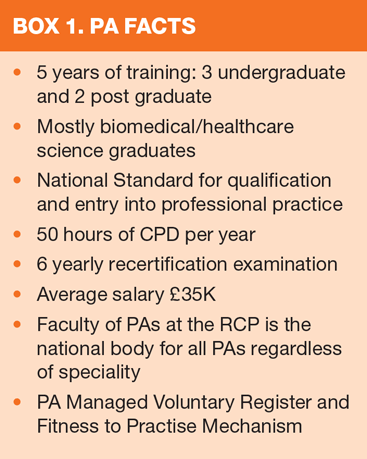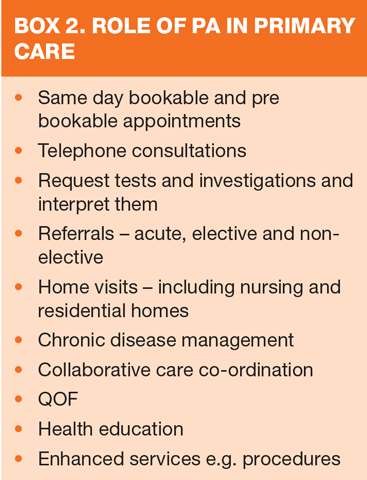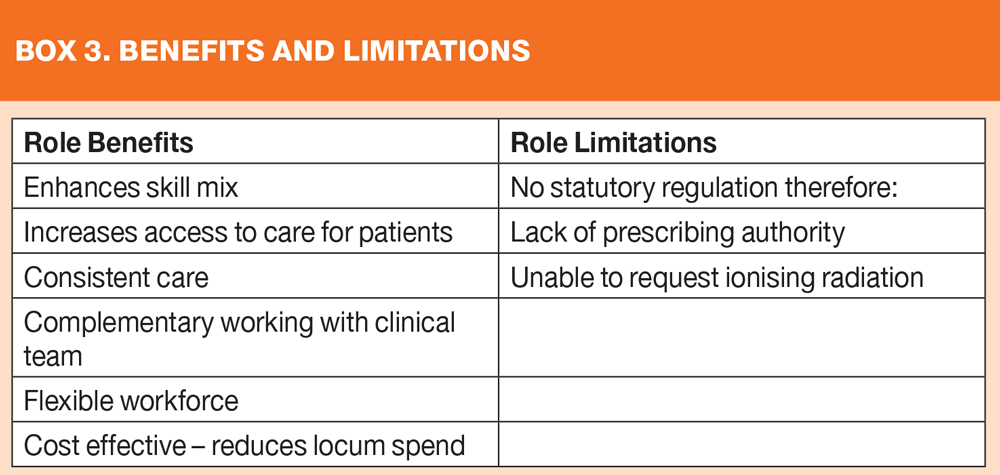Physician Associates — new kids on the primary care block
Jeannie Watkins
Jeannie Watkins
Physician Associate, Registered (PA-R) Senior Lecturer and Clinical Placement Lead PA Studies, St George’s University of London, Director for Regulation, Faculty of Physician Associates at the Royal College of Physicians.
There is considerable overlap between the roles of advanced nurse practitioners and physician associates, but in busy practices (and aren’t they all?) there is room for both skill sets
The physician associate (PA) is an emerging and rapidly growing health professional group in the UK. PAs are trained to provide medical care for patients, and they work in a variety of medical specialities across primary and secondary care as part of the medical team. This article aims to give a clear overview of the profession, education and training of PAs and consider the benefits and impact the role can have in primary care.
WHAT IS A PA?
The PA is a new breed of healthcare professional. PAs are trained specifically to work in medicine (using the medical training model) with a broad range of medical knowledge and skills. These skills are used to increase access to care for patients and can support the workload of doctors in primary care. Previously known as Physician Assistant in the UK, the PA has been defined as:
‘a new healthcare professional who, whilst not a doctor, works to the medical model, with the attitudes, skills and knowledge base to deliver holistic care and treatment within the general practice team under defined levels of supervision’1
A PA can:
- Formulate and document a detailed differential diagnosis having taken a history and completed a physical examination
- Work with patients and, where appropriate, carers to agree a comprehensive management plan in light of the individual characteristics, background and circumstances of the patient
- Maintain and deliver clinical management in collaboration with the patient and on behalf of the supervising physician whilst the patient travels through a complete episode of care
- Perform diagnostic and therapeutic procedures and prescribe medications (subject to the necessary legislation)
- Request and interpret diagnostic studies and undertake patient education, counselling and health promotion.
PAs are able to practise medicine through delegated authority from their supervising doctor (under the General Medical Council delegation clause2) and although dependent practitioners, can work autonomously in providing medical care for patients. While this is a relatively new profession in the UK (over 10 years old) it is well established globally, particularly in the USA where the profession is almost 50 years old with over 100,000, certified PAs and 200 PA programmes.3
PA EDUCATION, TRAINING AND ASSESSMENT
PAs have been training in the UK since 2004 (mainly under pilot projects) with the first students graduating in 2007. During the pilots, the Department of Health in conjunction with the Royal College of Physicians and the Royal College of GPs, and in consultation with 300 other bodies, developed the Competence and Curriculum Framework for the Physician Assistant.1 This document provided the foundation for the PA profession setting the minimum standards for the education and training of PAs and specifying the range of competencies expected of a PA at the point of qualification. This document currently sits with the Faculty of Physician Associates (FPA) based at the Royal College of Physicians (RCP). The first programmes based on the requirements of the Competence and Curriculum Framework (CCF) started after its completion in 2006.
PA students are mainly life science graduates who have undertaken a 3-year undergraduate degree and have some healthcare or customer service experience. PA students undergo a 2-year intensive clinical medical education programme covering the breath of common and important conditions that are seen across a range of medical specialities. Students develop a sound knowledge base in clinical medicine and develop comprehensive clinical examination skills which form the basis of their generalist medical education, enabling them to enter work in any medical specialty. PA students are trained to take medical histories, carry out physical examinations, formulate diagnoses, request and interpret investigations, undertake procedures and develop treatment and management plans. Once PAs successfully complete their university programme they are then eligible to undertake the PA National (knowledge and skills based) Examination to enable them to enter professional practice. As of March 2016 there are 14 PA programmes in the UK and by the end of the year there are likely to be 25-30 programmes. It is estimated that by 2020 there will be 2,500–3,000 PAs working in the NHS. Jeremy Hunt has also announced that by 2020 there will be 1,000 PAs working in primary care.4
According to the FPA 2015 PA census there were 223 PAs and 191 PA students in the UK in April 2015.5 The majority of PAs are employed in secondary care, however primary care is beginning to see the value of this role and despite small numbers of PAs currently employed in general practice (35-40), general practice is currently the largest speciality employer of PAs, with Acute Medicine and A&E rapidly closing the gap. The average salary for a PA in the UK is around £35,000.
Once qualified, PAs are required to maintain 50 hours of CPD per year and recertify every 6 years across the breadth of medicine. They must pass the recertification knowledge based exam in order to continue to practise.
GOVERNANCE FOR PAs
There are two main organisations that work in collaboration to oversee and support the PA profession, the FPA at the Royal College of Physicians (RCP), and the UK and Ireland University Board for PA Education (UKIUBPAE). The FPA is the professional body representing PAs working in all specialities and is responsible for:
- Accreditation of PA programmes
- Continuing Professional Development (CPD)
- National Certification and Recertification Examinations
- Administering the PA Managed Voluntary Register (which includes a fitness to practise mechanism) until Statutory Regulation is achieved
- Lobbying for Regulation (which once achieved will automatically enable PAs to order ionising radiation) and prescribing rights for the profession
The UKIUBPAE currently brings together the universities with established or pending PA programmes. The purpose of this Board is to enable programmes to share good practice and review and advance PA Education and develop PA educators.
WHY DO WE NEED PAs?
The PA model has been adopted in the UK in response to the medical workforce crisis, changes to junior doctors’ training, changes to immigration laws and to manage the impact of the European Working Time Directive. It has also been developed in a bid to meet increasing public expectations for choice and access to care, and the needs of an ageing population with multi-morbidity and increasing frailty. These issues have created service gaps, which despite the best efforts of other existing healthcare professionals extending their roles, just cannot be filled.
In the 5 year Forward View Health Education England (HEE) sets out how it will deliver the changes that the NHS needs in order to future proof the service and provide for the needs of the population.6 Part of the solution is to look at the skill mix and develop new models of working and invest in a workforce that can be flexible to meet the population’s needs. It also aims to radically alter the way in which the workforce is trained and plans to ensure it does not lock itself in to outdated models of delivery.7 As part of the 10-point plan set out in Building the Workforce – New Deal for General Practice,8 NHS England and HEE have highlighted new ways of working and identified new workforce initiatives to support general practice.
THE ROLE OF THE PA IN GENERAL PRACTICE
The role that the PA will carry out in general practice will depend largely on the needs of the practice. However, most PAs working in general practice can perform a range of duties, including: urgent (on the day) and non-urgent face-to-face consultations, home visits (including nursing and residential homes), referrals to other professionals and services, requesting, reviewing and interpreting results, chronic disease management, treatment of patients, and health promotion and prevention of illness education. PAs also support students and other healthcare professionals working in primary care. In addition, PAs can undertake a range of clinical procedures including flu vaccinations, spirometry, and minor surgery. It has been confirmed recently that those PAs on the PA Managed Voluntary Register are now eligible to undertake the Cervical Screening Smear Takers course, and upon successful completion, take smears.9
Currently there are limitations to the role. PAs are not yet a regulated healthcare professional group and as such they are unable to prescribe or request ionising radiation. Both of these limitations could be conquered with the advent of statutory regulation. These issues are being actively addressed by the FPA at a national level.
BENEFITS OF A PA TO THE PRIMARY CARE TEAM
There are a range of potential benefits that the PA role can bring to enhance the service already delivered in primary care. The PA role provides an opportunity to improve and develop the skill mix, further increasing patient access and decreasing the medical workload. In several studies PAs were found to be acceptable, effective and efficient in complementing the work of GPs, and that PAs (due to their broad medical knowledge base and skills) can provide a flexible addition to the primary care team.10 Studies also reported high levels of patient and doctor satisfaction, concluding that PAs are competent and safe, as well as being productive in terms of handling appointments and cost.11,12 Therefore employing PAs may help to reduce GP locum budgets, and provide consistency and continuity for patients.
PA, ADVANCED NURSE PRACTITIONER OR BOTH?
This is a frequently asked question in primary care as advanced nurse practitioners already provide medical care to patients. There are several differences between these professional groups: initial purpose of the roles; training and education; scope of practice; regulation; training standards and assessment; validation and recertification; limitations to individual’s practice and clinical supervision. However, It is abundantly clear that whatever their differences, they have many commonalities – mainly consulting, diagnosing, managing and treating patients. There is benefit to primary care services and to patients in employing a variety of clinicians, who have a range of expertise, across the broad spectrum of medicine to deliver the care that is required. There is increased choice for patients, increased access to care (more appointments) and more flexible cover for GP leave and sickness. It is important for the practice to evaluate its current service needs and then decide which professional is best placed to deliver these, ensuring that the patient sees the right person with the right skills at the right time. The PA, ANP and practice nurse can work well together to complement each other and deliver excellent patient care.
CONCLUSION
PAs are part of the solution to the medical workforce crisis and the role may have much to offer in primary care. The number of PA programmes and consequently qualified PAs is rapidly expanding across the country with demand for PAs currently outstripping supply. It is not the only solution to the current challenges facing general practice but can at least help relieve some of the pressures. The PA role in primary care is not a replacement for any other member of the primary care team and should not be considered as a threat to other professional groups. The key to the development of the role is in the regulation of the profession, and once this happens PAs can work to their full potential and really make a significant difference to supporting the medical and healthcare workforce in the provision of patient care.
REFERENCES
1. The Department of Health (2006) The Competence and Curriculum Framework for the Physician Assistant, DH, Revised 2012 http://static1.squarespace.com/static/544f552de4b0645de79fbe01/t/557f1c1ae4b0edab35dd92cf/1434393626361/CCF-27-03-12-for-PAMVR.pdf (Accessed 1st March 2016)
2. General Medical Council. Delegation and referral. 2013. http ://www.gmc-uk.org/guidance/ethical_guidance/21187.asp (accessed 7th March 2016)
3. National Commission on Certification of Physician Assistants. http://www.nccpa.net/Uploads/docs/2014StatisticalProfileofCertifiedPAsPhysicianAssistants-AnAnnualReportoftheNCCPA.pdf (Accessed 9th March 2016)
4. Hunt J. (2015) https://www.gov.uk/government/speeches/new-deal-for-general-practice
5. Ritsema T. (2015) Faculty of PAs Annual census http://www.fparcp.co.uk/census/
6. NHS Five Year Forward View https://www.england.nhs.uk/wp-content/uploads/2014/10/5yfv-web.pdf(Accessed 7 March 2016)
7. Health Education England. Investing in people for health and healthcare. Workforce plan for England. Proposed Education and training commissions for 2015/2016. https://www.hee.nhs.uk/sites/default/files/documents/Workforce-plan%202014-15.pdf
8. NHS England and Health Education England. Building the Workforce – the New Deal for General Practice, 2015. https://www.england.nhs.uk/commissioning/wp content/uploads/sites/12/2015/01/building-the-workforce-new-deal-gp.pdf (Accessed 7th March 2016)
9. NHS Public Health England, National Cervical Screening Programme, 2016. http://i.emlfiles1.com/cmpdoc/7/7/8/6/8/files/356831_cervical-screening-programme_physician-associate-eligibility-criteria-to-undertake-cervical-sample-taker-training-march-2016.pdf?utm_source=Membership&utm_medium=email&utm_campaign=6868204_FPA%3A%20Screening&dm_i=1V19,437JG,KMS87Z,ETOGC,1
10. Drennan VM, Halter M, Brearley S, et al. Investigating the contribution of physician assistants to primary care in England: a mixed-methods study. Health Serv Deliv Res 2014;2(16)
11. Drennan VM, Chattopadhyay K, Halter M, et al. Physician assistants in English primary care teams: a survey. J Interprofessional Care 2012; Early Online: 1–3.
12. Williams L, and Ritsema T (2014). Satisfaction of doctors with the role of physician associates Clinical medicine Vol14, NO2 113-116
Related articles
View all Articles


